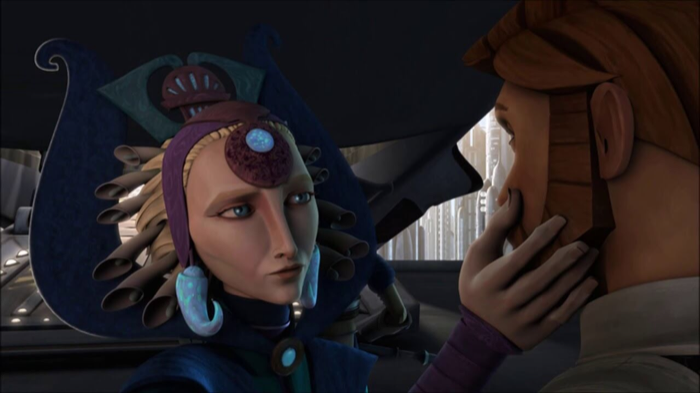How Qui-Gon And Obi-Wan’s Pasts Can Illustrate Why Qui-Gon’s Death Made Anakin So Easy To Turn
“If you would just follow the code, you would be on the Council. They will not go along with you this time.”
“You still have much to learn, my young apprentice.”
The defeat of Qui-Gon Jinn at the hands of Darth Maul in The Phantom Menace had much stronger implications than we knew at the time. Qui-Gon was, of course, a very powerful Jedi and a huge loss to the Order, but could he also have been the strongest line of defense between Anakin and Palpatine’s nefarious plans? If he had survived the Duel of the Fates, could he have kept Anakin in the light?
Novelizations set before The Phantom Menace may provide some insight. Many of these stories, while not officially canon, are largely considered canon in that nothing has yet contradicted them. Their accounts of Qui-Gon and Obi-Wan’s relationships, passions, and surprisingly intense conflicts with the Jedi Code can lay solid groundwork for conjecture about Anakin’s potential destiny.
RELATED:
The Jedi Apprentice novel series, written by Dave Wolverton and Jude Watson, provides detailed accounts of many of Qui-Gon and Obi-Wan’s missions together, right from Obi-Wan’s selection as a Padawan learner. It also introduces more characters at the Temple, including a Noorian Jedi named Tahl. Tahl grew up through the Jedi initiate system with Qui-Gon, and the two became very close friends. However, into adulthood, the two went on more and more missions together, and their bond transcended friendship and became something more. Although it was against the Jedi Code, the two pledged their lives to each other.
Shortly after this, Tahl was kidnapped on a mission to New Apsolon, a world known to both Qui-Gon and Tahl from a previous mission. A man named Balog, after pretending to assist the Jedi, kept her in a sensory deprivation device that drained her of her strength. Qui-Gon was eventually able to rescue her, but she succumbed to her injuries and died in his arms.
After this tragedy, Qui-Gon became unrecognizable, even to his Padawan. The pain of the loss drove him to the edge of the dark side, and he relentlessly pursued Balog with vengeance in his heart. He was even prepared to kill the man for his crime, but Tahl’s voice appeared in his head, and it stopped him. Regaining control of his feelings, he turned Balog in to the planetary authorities and returned to Coruscant with Obi-Wan.
Obi-Wan, too, dealt with loss and grief in his earlier years. On a mission with Qui-Gon to a world called Melida/Daan, he felt a strong connection to a group called The Young, fighting for peace between two older factions who couldn’t even agree on a name for their planet. He grew close with a young woman named Cerasi, and his feelings were so strong that he left the Jedi Order to join her and her cause. After the war was won, Cerasi was killed by a hired sharpshooter. Obi-Wan was devastated, but there was nothing left for him on that world, and he was eventually allowed back into the Order.
Obi-Wan suffered the death of another potential romantic partner in Duchess Satine of Mandalore. In the fifth season of The Clone Wars animated series, Darth Maul holds Satine in front of Obi-Wan, choking her and urging Obi-Wan to give in to his anger and hate. Obi-Wan refuses, and Maul murders her in front of his eyes. Maul’s forces then take Obi-Wan to a prison cell, where he mourns Satine, but still does not succumb to the dark side of the Force.
This last distinction is important. Obi-Wan, suffering loss, pain, and grief throughout his career as both a Padawan and a Jedi Knight, was never tempted by the dark side in the same way Qui-Gon and Anakin were. He displays numerous Jedi flaws: naïveté, impulsivity, and even uncontrolled emotion. But he stays firmly in the light.
Now, let’s consider Anakin Skywalker. Disadvantaged from the start (with such a strong connection to his mother), he fell in love with Padmé and would do anything to save her. When his mentors on the light side failed him (Obi-Wan either didn’t know or pretended not to know, and the Council and Code made it clear that it wouldn’t be tolerated), he had no choice but to turn to his other mentor, the Chancellor. Palpatine was then able to convince him that the dark side was the only way.
This, ultimately, was a failure of Obi-Wan. Either he was too out-of-touch with the living Force to realize what his Padawan was going through, or he was so dedicated to the Code and Council that he was unable to breach the subject with Anakin. Qui-Gon, however, had a very intense personal experience with love, loss, and the temptation of the dark side of the Force. Additionally, his connection to the Force was so strong that he found a way to transcend death, keeping his consciousness in existence to communicate with those still alive.
These insights support the conclusion that if Qui-Gon had survived, he may have: 1) sensed the nature of the struggles that Anakin was facing internally, and 2) had the wisdom and personal experience to guide Anakin through his conflict, keeping him in the light and saving the countless Jedi eventually murdered by Darth Vader. Who knows…he may even have been able to discover Palpatine for who he was, identifying the Sith threat to the galaxy before it was too late.
Theories like these give additional depth and meaning to The Phantom Menace, and specifically, the Duel of the Fates; it may have indeed been the battle to decide the fates of Anakin, the Jedi, and the galaxy.
READ NEXT:
Source(s): Wookieepedia





